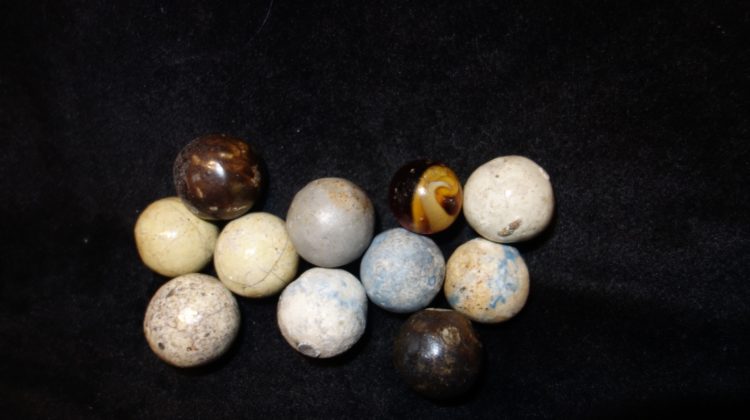
Every collector has a particular way of going about it. Some collect only Peltier Glass Company (“Pelts”) and some are even more specific than that: they only collect National Line Rainbos (NLRs) or Comics.
Others are crazy about sulfides and German swirls and they spend their time and money searching high and low for for these. Some collectors are even happy to pay for a neat polish and repair on these German imports.
Still others collect contemporary art marbles. We have explored art marbles in our posts Regional & Local Glass Marble Artists and Contemporary Art Glass Marbles.
But why not add non-glass marbles to your collection along the way? Even if you know nothing about them to start they can teach you a lot about marble history. “The jungle is dark but full of diamonds, Willy.” ― Arthur Miller, Death of a Salesman
The Marble Fiefdom
Over the last couple of decades we have met hundreds of collectors, marble makers and artists, and antiques dealers who buy, sell, and collect marbles. We have met the princes and the paupers of the marble fiefdom as well as the gypsies and the beggars.
One pattern recurs time after time. Marble collectors love glass! And most of the time glass and only glass! Old, new, badly dinged from hours of play, someone will want it and treasure it. We are delighted with glass, too, and have found/dug and bought some stunners over the years.
We have fallen down deep gullies, got our share of cuts and bruises, and collected a nail through the shoe in Central Pennsylvania. And we have had some wonderful times along the way. As you can see in our story, Dragons and Farbles With A Pinch of Pewter, we are very eclectic collectors.
Dirt & Rocks?
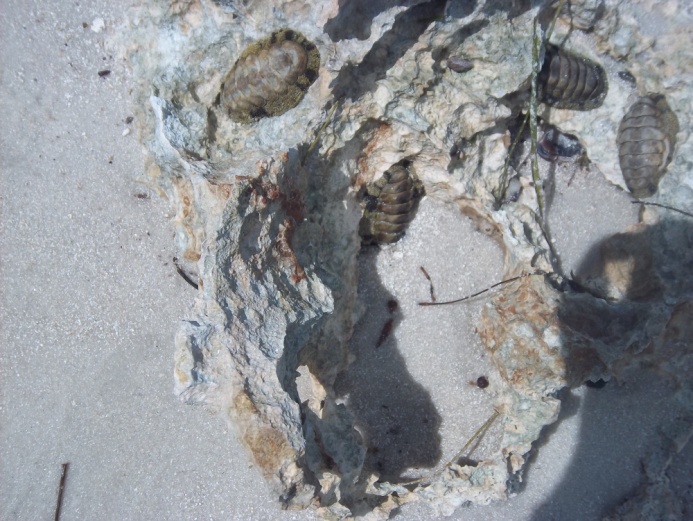
Seriously. The principle reason we collect marbles is for their history. Thus our book The Secret Life of Marbles.
Every marble has a story, and some marbles have so many stories that you could never run them all to ground!
And the cheapest marbles we ever bought were clay and stone. We have even been given any number of expensive old marbles just because the collector did not like them. The marbles were dull. And, anyway, he or she had no idea what they were and had no time, interest or way to find out.
And, while cheap, these antique marbles have provided us hours and hours of enjoyment while learning everything we could about them.
The Chicken before the Egg: Mahenjo Daro
Remember, clay and stone marbles have been around much longer than glass.
“Marbles, in one form or another, have been around for thousands of years, and have been found in archaeological contexts all over the world.
The earliest marbles were made of polished stone, followed by small, round balls of fired clay. There are no … sources that explain exactly how marbles were used in ancient Mesopotamia, Egypt, the Indus Valley, the Americas [ie by the Aztecs], Greece, or Rome, but there is sufficient information to demonstrate that early marbles served a variety of recreational purposes for children and adults alike.”
In Mahenjo Daro some 4,000 years ago children, and probably adults too, played marbles with a clay maze very much like some we find in shops today and which many of us have in our collections. In Chapter 1 of our book is “Where Do Marbles Come From and Why?” we write about toy marble origins.[1]
Who You Gonna Call?
We use three primary references when working with non-glass marbles: Everett Grist’s Antique and Collectible Marbles, 3rd Ed.; Paul Baumann’s Collecting Antique Marbles, 4th Ed.; and Jeff Carskadden, Richard Gartley, etc. “Marbles—Stone, Mineral, Clay, Pottery, Porcelain, and China,” in Stanley A. Block’s Marble Mania®, 2nd Ed.
These listed books are the place to start reading. We have had less luck online, but do check there, too. And if you unearth museums or collector clubs, local, regional, or national, which have samples of the clays or slips and glazes that you are studying don’t hesitate to contact an archivist there or a volunteer. You will be amazed at the help and support you can garner. We have met some wonderful people this way.
Talk to the Seller if Possible
First, ask the dealer or seller you buy from about the marbles. What does he or she know about them? How did she or he get the marbles and do they remember when? Does the dealer know how old they are? Did he know whomever he bought them from? We even learned once that the marbles in question were stolen!
Another time a seller had a hand full of indigenous clays from an odd little place in northern Florida which we knew a little about. While at the flea market we thought that his fantabulous story could not be true, but it was a jumping off place. Well, it was both true and incredibly impossible at the same time!
Hidden Treasure
We attended the 2023 Daphne bottle show and, as expected, we found some nice non-glass marbles for sale for almost nothing[2]. We bought this little clutch at the Show.
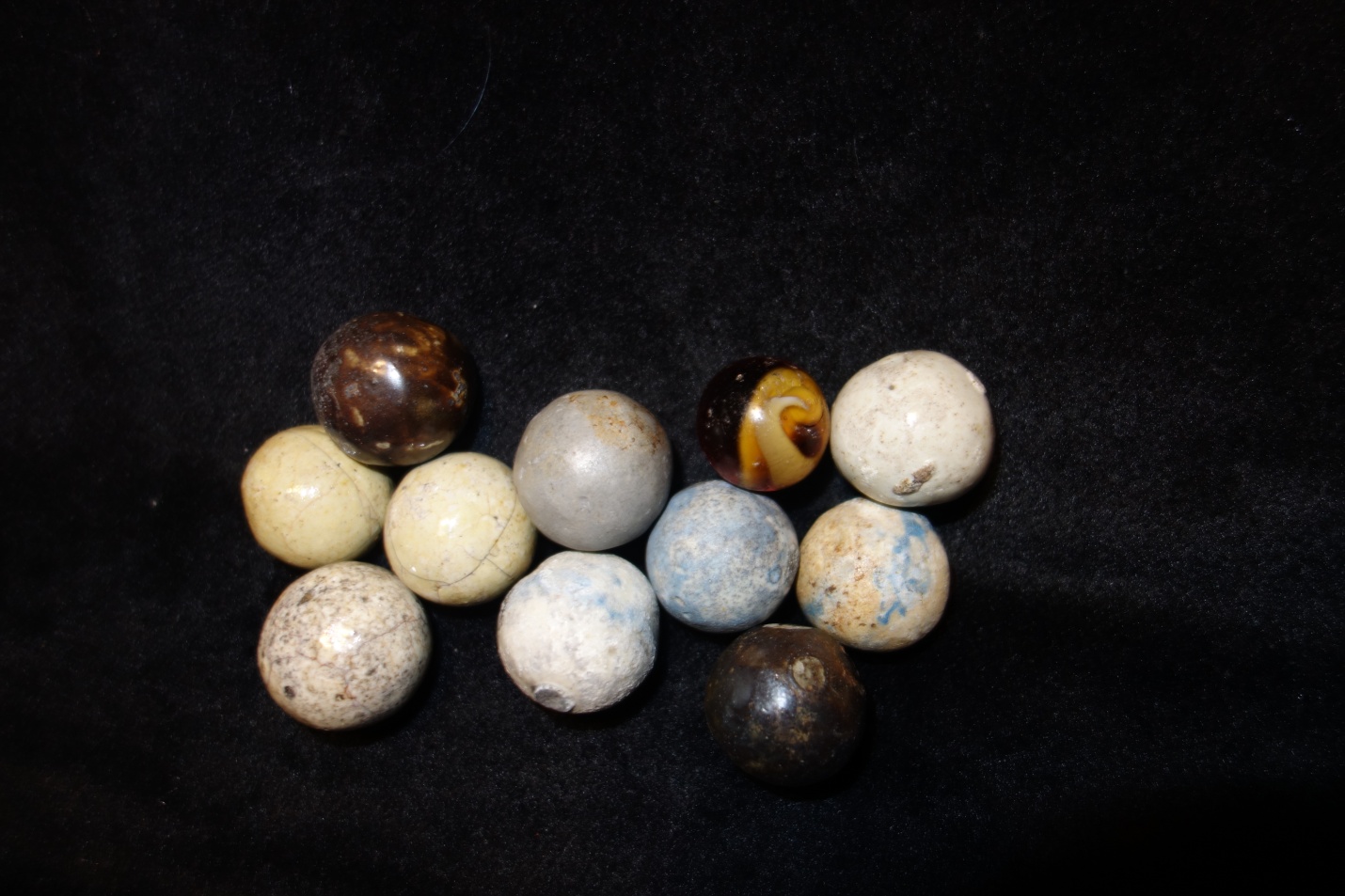
We are using our featured photo again to tell you a little something about them just to give you an idea of how much history can be stored in such a small clutch of marbles. You will have to decide with each lot you get, large or small, just how much you want to research them.
New York Potters
The seller at the Bottle show could only tell us that these came from New York State historic potters. He explained that the marbles were not made commercially by the potters, but were “end of day” works by the potters for their children. The earthenware, slips, and glazes were applied from whichever materials the pottery had on hand.
We knew about this type special after-hours potters’ work from our research and field study in Thomaston, Upson County, Georgia. These adventures are told in Chapter 3 “Schlepping Off to Jugtown” in The Secret Life of Marbles….
While we know nothing about individual historic New York potteries, we do know that in the late 1940s there was a movement of academic study toward regionalism in the history of New York pottery making.
Help!
There are a few fantastic books about New York state pottery. Over the years we have bought such references to study our marbles. But first check out the books we list. These are broad enough to use again and again on all type of marbles you either have in your collection or which you may buy along the way.
After checking the listed books you might also want to explore “Ceramics of the United States by Region” published by The Smithsonian online. [3]
While we can’t tell you the potter who made a particular marble, or even whether the marbles were made in the Mohawk or Hudson River Valleys or along the Saint Lawrence, we can tell you something about the clay and glazes used.
As a general rule, the clay, slurry slip, and glaze all reflect the geology of the region or location where the ceramic is made. A pottery collector can often tell where the ceramic was made if she can see can see the paste under the glaze. And, of course, the decoration itself is often used as another diagnostic.
Just A Few Things These Marbles Tell Us
- Spotted it, didn’t you? Top row, 2nd marble from the right. Yes, it is a glass amber slag. It may well be the newest marble in the lot. Baumann pages 118 – 119 is the best place to learn about this type marble. Almost certainly American, it is ⅞”, amber with a white swirl. It does have the tell-tale “9” caused when the gatherer dipped “…the [iron] punty into the [amber] base color, and then twirl[ed] it into the white and then back into the base….” The marble also has the distinct “blotch” cut mark made by the glass shearer. It was smoothed unlike so many which were left pretty rough. The marble was made by Navarre Glass Marble and Specialty Company in Ohio sometime between 1896 – 1902. Before you decide that this one is as rare as hens teeth note that Baumann tells us that if five or six workers worked daily then they could make about 150,000 such marbles a week!
- Just to the left of the glass marble and about in the middle of the lot is a 1” blue-gray marble. Find it? It is decorated stone. We have thought of this odd blue-gray stone as Dutch since we researched shipwreck marbles[4]. This one had a helix painted around its middle. It is planar: hand made. There is a chip into the stone which allows us to confirm that it is a very hard limestone very much like slate. Research tells us that it is Famennian sandstone which is also called Condroz psammite. “…Dark brown to greyish blue sandstone is very well stratified with mica plates parallel to the bedding plane making it easy to split it. The durable Famennian sandstone, first exploited in the Middle Ages in small quarries….[5]” We added the emphasis. While the Condroz region is in Belgium, this sandstone was used in the Netherlands for building and infrastructure. It is an unusual stone with an unusual color not easy to forget.
This Blue-Gray Marble points to Dutch New York Potters
Ok. But were there Dutch New York state potters? Again, while not digging too deep we find this: “The Dutch in New York Pottery–Earthenware clay is abundant in the hillside running from the east of Bath, north along the Hudson River to the City of Troy. While it has not been positively documented, the existence of this readily available clay may have led either American or 17th century Dutch potters, brick or tile makers, to operate kilns at Greenbush at some early undetermined date. Two 17th and 18th century references to the Dutch name ‘Calenbacker’ refer to locations in Greenbush, prompting a careful analysis of the possible origins and meaning of this name.”[6]
So, yes, the Dutch were historically involved in the pottery art and trade in the state of New York.
We know that historically slate has been quarried in New York, for example in the Slate Valley which extends for miles along the New York and Vermont borders. The stone may have been imported or mined locally. And the Dutch may have made the marble and decorated it in New York or they may have brought it with them.
Slips and Glazes
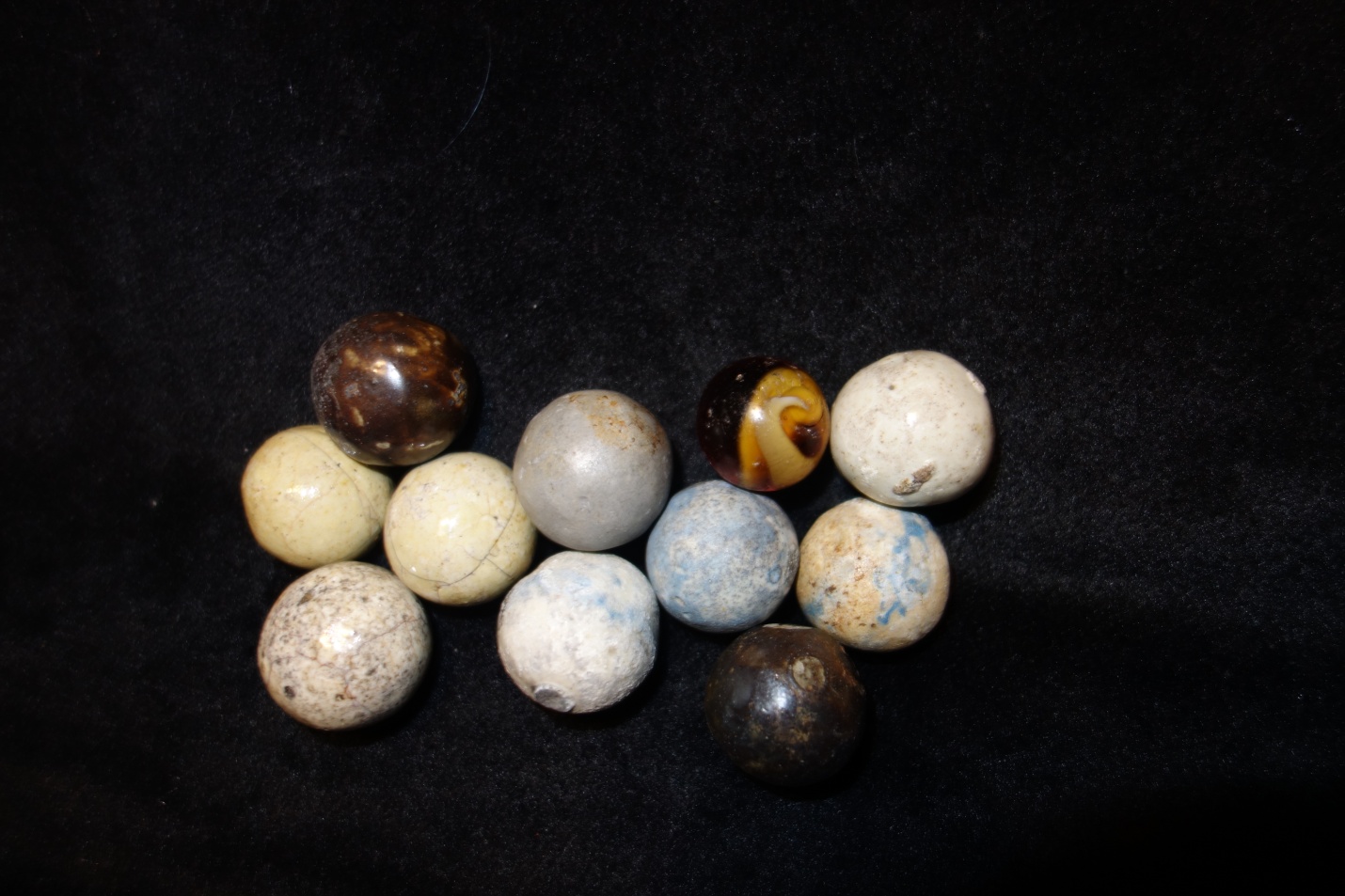
- The marble on the bottom row, far left is 1⅛”. It is as distinctive in its own way as the blue-gray stone. We cannot determine its paste, but it is a clay of some sort. The slip glaze gives the impression of varnish, and the marble is very shiny. Slip glaze is a fluid suspension of clay or other similar material in water which is applied to the surface like a slurry. In this case the slurry was applied to the marble before firing to form a coating which is usually a different color from the paste. The slurry on this marble is almost clear.
- Slips can vary in luster, thickness and color. It is generally applied to marbles by dipping. UWFA[7] The glaze on this marble is tin oxide which causes a distinct bluish effect. This blue appears on the marble as tiny pinpricks of blue color. Scholars believe that this tin glaze originated in Africa and then arrived in England in the 17th century from, among other countries in Eurpoe, the Netherlands. This marble should not be confused with the marbles with blue inside nor with almost blue-slipped marble under the glass one.
Tin Glaze
- Two marbles, bottom left in the photo and above the tin glazed one, are both 1” . Each has a thick slip glaze which has crazed on both marbles. This is a Bristol slip which we most often see on ginger beer bottles; the lighter color which is generally on the bottom part of the bottle.
- Two of the marbles have “streaks” of blue which appear to be varigated clay. Both are 1”. One is on the bottom row middle and the other is on the 2nd row far right just above that very dark brown marble on bottom. These have a stoneware glaze slip which is matte-like with pinholes in the slip just like factory blow-outs in glass! Both marbles are mottled with blue in the slip.
- While these appear to be varigated clays, they are not. The blue color is on the surface only. The blue was probably added to a slip and is either tin-based or Delft. The oddest thing about the slip is that is appears to be bisque! This could have been done in firing or by blowing powder pigment on the surface of the marble.
The Bisque Taw
- We found a marble just like this bisque one described in The Helena Independent in 1892[8]. The writer of the stories called this size marble a taw and he noted that “…it should be considerably heavier [than the player marbles].” He disdained glass shooters, but writes that “the best one I ever had was an old china [clay] alley which had not been glazed after it had been painted and therefore was not perfectly smooth.”
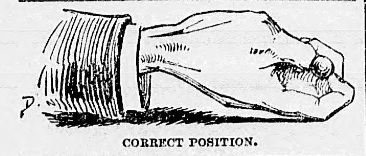
We have no idea what happened to this gentleman’s wrist! But this image is from the same newspaper stories as the one about the taw so it must be the correct way to shoot a marble!
Rockingham
- Finally, there are two marbles in the lot which are very hard to see. One is on the bottom row almost directly below the glass marble: far right. The other is on the top row to the far left.
- These marbles are brown glazed which looks like chocolate and which trends to black. One has very large “eyes”. We cannot be certain how this slip was applied: possibly simply by dipping the marble in the slurry. The first impression of the marbles is that they are brown “Bennington”. Unfortunately, some marble collectors refer to all brown glazed marbles as Bennington.
- However, this slurry or slip is Rockingham which dates to about 1830 – 1900. This medium to dark chocolate slip was achieved with yellow colored manganese over some type white or light pink paste. Some people call this the “beanpot” look.
Dat is alles Mensen!
What have we learned about non-glass marbles? They are not dull; they are not indistinct; and they do have a history.
These marbles are from upstate New York. They are old: almost certainly ca. 1830 – 1900. They were not made commercially or in any cottage industry, but they were created by potters who used end-of-day clays or paste and slips and glazes which had been used that day to make the commercial ceramics which were sold both locally and widely. They are hand crafted.
This is the reason that we see some odd glazes on the marbles. For example: Rockingham glaze was used both to decorate and seal small jugs and crocks. Bristol was popular on beer bottles of the era. Tin glaze was used on tableware and utilitarian ceramics of all kinds.
In effect, the marbles were just cream off the top of a utilitarian industry which saw the Dutch artists heavily involved for many years.
We conclude with our opening: We all need some Non-Glass Marbles!

Whoosh! I get tired just thinking about it!
Footnotes
- The Herring Run Archaeology Project https://herringrunarchaeology.org/2019/05/27/small-finds-big-stories-two-marbles-from-the-caulkers-houses/ 3/28/2023 “Small, ancient stone balls, identified by archaeologists as marbles have been unearthed near Mohenjo Daro, India and similar artifact have been discovered at prehistoric sites associated with Chaldeans of Mesopotamia.” You can check out some of the other artifacts found at Mahenjo Daro at https://indusvalleycivilizations.weebly.com/artifacts.html 3/30/2023 ↑
- And we also found some fine antique glass and China marbles. The dealer knew very well what these are and what they are worth, but, as we have noted in a prior post, if marble collectors don’t know about Bottle Shows, then they should add Bottle Shows to their itinerary. ↑
- https://www.si.edu/encyclopedia_si/nmah/usregcer.htm 4/1/2023 ↑
- Shipwreck Marbles: Found from Wreckage and Shipwreck Marbles: The Rest of the Story ↑
- C.W. Dubelaar, P.J.M. Kisters, and J.W. Stroucken. “A natural-stone city walk through Maastricht, the Netherlands.” Netherlands Journal of Geosciences — Geologie en Mijnbouw | 90 – 2/3 | 197 – 208 | 2011. ↑
- Warren F. Broderick and Patricia Barbanell. “Early Potters in Greenbush.” The Hudson Valley Regional Review, September 1988, Volume 5, Number 2 PDK, page 13.↑
- Most of our references about slip glazes and ceramic types, etc., unless otherwise noted, is from working papers used at the University of West Florida Archaeology Lab where Larry volunteered for 5½” years.
- The Helena independent. [volume], April 17, 1892, Morning, Page 12, Image 12
- About The Helena independent. [volume] (Helena, Mont.) 1875-1943↑

